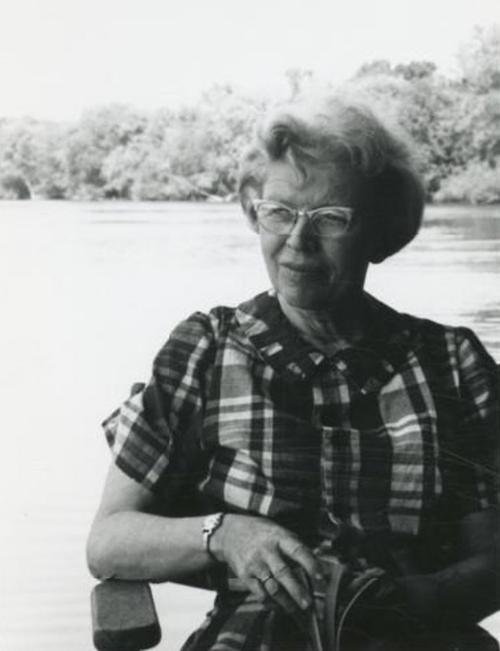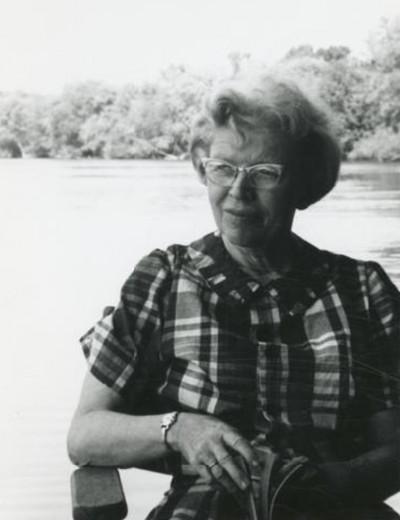“O My Floating Life”: In Search of the Elusive Wisconsin Poet Lorine Niedecker’26
Lorine Niedecker’s poetry was on the cutting-edge of 20th century modernism, but it was largely unknown and unrecognized until years after her passing in 1970. Passionate advocates hope to raise her profile on campus and throughout the Midwest.
Poet Lorine Niedecker may be one of Beloit’s — and modern literature’s — best-kept secrets.
Niedecker, who was born in 1903, would have graduated from Beloit College in 1926, but dropped out after her sophomore year to take care of her ailing mother in the poor, rural community of Blackhawk Island, just outside of Fort Atkinson, Wis. She was a prolific and reclusive writer, crafting sparse, nature-based poems in her one-room cabin alongside Lake Koshkonong.

Passionate advocates like the Friends of Lorine Niedecker — a Fort Atkinson-based nonprofit — as well as Beloit College Archivist Emeritus Fred Burwell’86 and Professor of English Chris Fink hope to raise her profile on campus and throughout the Midwest.
“I see my work as telling her story to Beloit and the region,” says Fink. “Ironically, she’s always been better known away from Wisconsin.”
Her modern friends hope that one day, her name will be known alongside those of Dickinson or Gertrude Stein or E.E. Cummings — and that she’ll be seen as not a regional woman poet, but as one of the most innovative and original writers of her time. Their advocacy has targeted writer’s circles and local businesses, as well as classrooms in both Fort Atkinson and at the college she once called home.
Poet of place
Blackhawk Island — which contained a single dirt road during Lorine Niedecker’s adolescence — is a low-lying peninsula prone to flooding by the Rock River. Except for a brief stint living in New York with Zukofsky during her late 20s to early 30s, Niedecker considered the small rural community her home and her greatest source of inspiration for the remainder of her life.
While she was young, her father, Henry, owned financially unsuccessful properties and businesses in town and was a noted fisherman, while her mother, Daisy, who was withdrawn and increasingly hard of hearing for much of Niedecker’s youth, tended to the home and garden. Her childhood influenced many of her poems through images of infidelity, instability, poverty, deafness, and fishing. But so did depictions of Blackhawk Island’s beauty: springtime, flowers, birds, and rebirth.
Niedecker was a member of a small group of second-wave modernist poets who called themselves the Objectivists. Their poetry contains concrete imagery, often with short lines and precise, rhythmic language. Writing a poem in this style was a process she called “condensery.” Niedecker’s poems are deeply personal and feature indentations and lines that ebb and flow on the page like water. She wrote countless short poems, but a number of lengthy poems, too, like “Paean to Place.” One of its many sections reads:
O my floating life
Do not save love
for things
Throw things
to the floodruined
by the flood
Leave the new unbought—
all one in the end—
water
Lines from this famous poem are featured in bright lettering on the southeast corner of North Main Street and Sherman Avenue in Fort Atkinson, one of three murals downtown. The mural, created by Jeremy Pinc, reads:
Fish
fowl
flood
Water lily mud
My life
Objectivism is about illustrating things or ideas as they are in nature. Much of Niedecker’s poetry was concerned with rhythm and onomatopoeia — making words sound and feel like the objects they describe. In doing so, many of her poems feel surreal or even fragmented or distorted, containing multiple intended interpretations, like [Popcorn-can cover]:
Popcorn-can cover
screwed to the wall
over a hole
so the cold
can’t mouse in

Niedecker lived in relative poverty for most of her life, funding her books with odd jobs, from writing biographies for the Federal Writers Project to proofreading to cleaning in a local hospital after her eyesight deteriorated. Although Niedecker maintained a life of relative solitude, she settled down with industrial painter Al Millen in her late 50s, living with him in Milwaukee briefly before returning once again to Blackhawk Island in her last few years of life.
Beloit as a literary home
Niedecker was always a bright student. At Fort Atkinson High School, she was involved in debate, the glee club, and the yearbook, even publishing a few poems and humor stories in its pages. Her senior quote mentions the “sweet serenity of books.”
Knowledge of Niedecker’s time at Beloit College is somewhat limited by the small number of her documents housed in the Beloit College Archives. With only a few mentions of her in college publications, little evidence points to how the classes she took or activities she enjoyed could have impacted her life and later work. Her college transcript indicates that she received good grades in English, music, French, biblical literature, and philosophy, but subpar ones in economics and botany.
Niedecker lived in Chapin Hall, an all-women freshman dorm, during her first year and the smaller all-women Stowell Cottage the following year. The college newspaper, the Round Table, included stories about literary figures who visited in the two years Niedecker was a student, including the current editor of Poetry.
The Round Table reported that “Laurine” Niedecker attended a meeting for Ka Ne, a journalistic sorority, in the spring of 1923 and even read two poems, “Fever” and “Lake Koshkonong,” along with a group of other freshman coeds. The paper wrote that the poets “showed ability and originality in every instance. It was noticeable that the trend was away from the beaten path and a venture made into more modern subjects and methods of treatment.”
Unfortunately, Niedecker’s mother had been growing increasingly ill during her Beloit years, and her father had become unable to help fund the rest of her education. Tuition and fees were $231, and room and board was $125, neither of which the family could afford. By the summer of 1924, Niedecker was back on Blackhawk Island, her education cut short.
English and creative writing professor Chris Fink collaborated with archivist Fred Burwell’86 and the Friends of Lorine Niedecker to help establish Beloit College as the writer’s academic home, acquiring volumes of her poetry and compiling and requesting rare books and other artifacts to keep in the archives. Beloit College Magazine reprinted an Associated Press story about her in 1996, adding a sidebar from Burwell that gave context about Niedecker’s time at the college. Burwell encouraged students and patrons to research more about Niedecker, while Fink brought one of Niedecker’s foremost biographers, Jenny Penberthy, to campus in 2018 to talk about the poet’s years at the college.
Fink hopes that the poet’s work and story will spark more opportunities to collaborate with the Friends and inspire other Beloiters and college visitors — perhaps with a mural in the Powerhouse or a display in the renovated library.
Teaching Lorine Niedecker
Fink first learned about Niedecker in graduate school at the University of Wisconsin-Milwaukee when a professor brought his class to see Niedecker’s cabin. He became fascinated with her work and connected with her life story.
“Her work has always really resonated with me — her life and themes are kind of close to my life in an interesting way,” says Fink, who grew up in a small, working-class town in Illinois. He sang Niedecker’s praises and found fellow fans while teaching in California before moving back to the Midwest to teach at Beloit.
“It was so obvious to teach her work at Beloit College,” Fink says. “She went here for two years. She’s Wisconsin’s most famous poet. Beloit has such a rich history of creative writing, and she’s such a pinnacle of that. And what an inspiring personal story of someone who comes from the region, who’s unknown, a first-generation college student. She didn’t graduate from Beloit, but it left an impression on her. Her personal story, as well as her poetry, has been inspiring to me and my students.”
Fink began to teach her collection The Granite Pail (1985) in his introductory creative writing classes, as well as his nature writing course in the Boundary Waters of northern Minnesota. In fall 2017, he created a first-year-initiatives course, called In Search of the Poet, dedicated to Niedecker’s life and work.
Fink’s first-year students discussed her biography by Margot Peters, annotated Jenny Penberthy’s Collected Works, and tried their hand at writing poetry in Niedecker’s style. Tony Renzema’22 was experimenting with videography, so Fink divided her poem “Paean to Place” into thematic sections for each student to memorize and recite for Renzema to film in various campus locations. Students also watched the documentary Immortal Cupboard: In Search of Lorine Niedecker (2009), which inspired the course’s name and themes.
That fall, Fink took the class to Fort Atkinson to attend the Lorine Niedecker Wisconsin Poetry Festival — organized by the Friends — to see a few readings and lectures about her life and poetry. Earlier in the semester, his FYIers learned how to conduct and transcribe oral histories, practicing first with English department faculty. At the festival, they conducted formal in-person interviews with Niedecker’s friends and family members which were later supplied to the college archives. Fink’s students also visited the Hoard Historical Museum, which has an exhibit dedicated to the hometown poet, as well as Niedecker’s cabin on Blackhawk Island.

Kiara Davis’21, a health and society major now earning her master’s in public health, remembers the trip to Niedecker’s cabin well. Originally from Salisbury, N.C., she had never been to Wisconsin before attending Beloit and was enchanted by Blackhawk Island’s timelessness.
“We sat by the river and I was thinking, back in that time, it was probably very quiet, and she would just come out here and look at Lake Koshkonong and write this poetry,” says Davis. “I sat in a rocking chair and could feel her presence. It was a humbling experience.”
Looking back, Fink thinks that the class worked so well because of its interdisciplinary nature. “We used her life as a way to study different genres and modes of writing; she was the glue,” he says. “She’s a poet who inspired artists from around the world, not just poets. I’m fond of how far-reaching her work is.”
Bringing her words to life
When Ann Engelman moved to Fort Atkinson in the early 2000s, she had no intention of becoming a self-proclaimed poster child for Wisconsin’s most famous poet. In fact, she didn’t even know who Lorine Niedecker was. During her first trip to the Dwight Foster Public Library, Engelman encountered a bookcase full of Niedecker’s books and got curious.
“The more I got into it, and the more I got to know library staff, the more it became clear to me that she was a pretty significant poet, and not just in Fort Atkinson or Wisconsin, but the world,” Engelman says. “Lorine was quiet and lived on Blackhawk Island, which was on the other side of the tracks in the ’30s, ’40s, and ’50s, which was not a good time to be a literary woman. Her work is not necessarily easily accessible initially, but I got a hold of Granite Pail, and after I read that, I thought, this is important. She really deserves more.”
She struck up a friendship with the library’s assistant director, Amy Lutzke, and was introduced to a group that had helped designate her home as a state historical marker in the early 1990s, which included volunteer Marilla Fuge, librarian Mary Gates, and Niedecker’s friends Gail and Bonnie Roub.
“Amy and I began to think that there should be an organization with an informal group of significant people who had known Lorine and those who found her story — just like I did — and were doing work to increase the visibility of her legacy,” Engelman says. In 2003, Fuge and Gates phased out of the group’s leadership, and Engelman and Lutzke stepped in, formalizing the Friends of Lorine Niedecker (FOLN) as a nonprofit organization the following year.
Over almost two decades of advocacy, FOLN has helped the community and the wider world to connect with Niedecker and her poetry. The group helped recover and relocate some of Niedecker’s papers and personal effects, the majority of which had been burned or discarded after her passing. Their website features biographical information, a database of photos and literature, an interactive map of important places, notes from the group’s past activities, information about upcoming events, and access to the group’s bi-annual publication, “Solitary Plover.”
Niedecker’s words have influenced countless poets after her, as well as readers who have stumbled upon her work. What started out as an appreciation for Niedecker’s language became something of a pilgrimage for Engelman after she first traversed Blackhawk Island. She was so moved to see the world Niedecker described in her poetry that she requested that the cabin’s owners allow people like Fink to speak on the property from time to time, in exchange for Engelman’s help in stewarding Niedecker’s former home.

Credit: Ann Engelman
Engelman says that Niedecker has become a part of her and the way she thinks about her relationship with her surroundings.
“I’m not a poet — I don’t understand a lot of poetry — but this woman needed to be not just recognized but appreciated,” Engelman says. “If you take a moment to internalize one or two of her poems, you’ll understand that her poetry of place invites you to look at your own place.”
Meg Kulikowski’21 is a writer and editor in the college’s Communications and Marketing Office. She fell for the work of Lorine Niedecker’26 when she took In Search of the Poet, a course created and taught by English professor Chris Fink.


